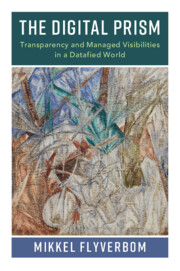Book contents
- The Digital Prism
- The Digital Prism
- Copyright page
- Contents
- Acknowledgments
- Introduction: The Transparency Formula
- 1 Digital and Datafied Spaces
- 2 Transparency and Managed Visibilities
- 3 People under Scrutiny
- 4 Organizations Gone Transparent
- 5 Seeing the World
- Conclusion: Life in the Digital Prism
- Bibliography
- Index
Introduction: The Transparency Formula
Published online by Cambridge University Press: 27 September 2019
- The Digital Prism
- The Digital Prism
- Copyright page
- Contents
- Acknowledgments
- Introduction: The Transparency Formula
- 1 Digital and Datafied Spaces
- 2 Transparency and Managed Visibilities
- 3 People under Scrutiny
- 4 Organizations Gone Transparent
- 5 Seeing the World
- Conclusion: Life in the Digital Prism
- Bibliography
- Index
Summary
Created in a dorm room at Harvard University, Facebook was a simple website set up to compare two pictures of female students at a time, inviting fellow students to mark them as hot or not. Since then, the scope and ambitions of Facebook have expanded considerably. Here is what Mark Zuckerberg said about the role of Facebook at a meeting on the financial results of the company ten years later: “Next, let’s talk about understanding the world. What I mean by this is that every day, people post billions of pieces of content and connections into the graph and in doing this, they’re helping to build the clearest model of everything there is to know in the world” (Facebook, 2013, italics added).
Information
- Type
- Chapter
- Information
- The Digital PrismTransparency and Managed Visibilities in a Datafied World, pp. 1 - 24Publisher: Cambridge University PressPrint publication year: 2019
